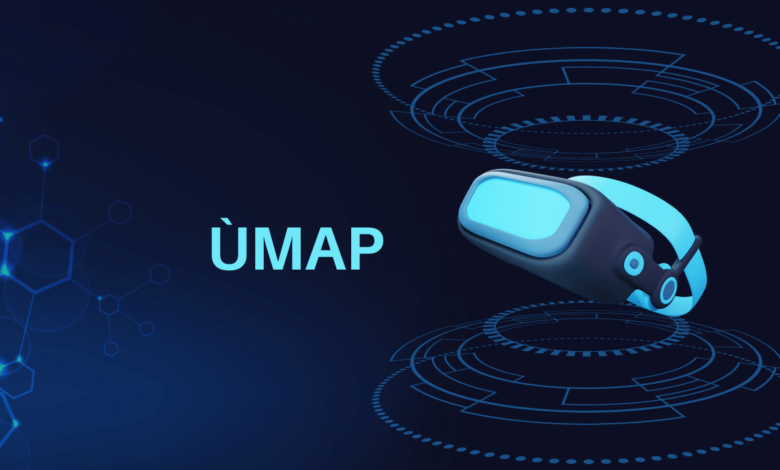Unlocking the Power of ÙMAP: Revolutionizing Data Visualization

The quest for efficient methods to interpret complex datasets needs to be expanded in data analysis and visualization. Enter ÙMAP, a cutting-edge technique rapidly gaining traction among data scientists, researchers, and tech enthusiasts alike. Short for Uniform Manifold Approximation and Projection, ÙMAP represents a breakthrough in dimensionality reduction and visualization, offering a versatile toolset to uncover meaningful insights from intricate data structures.
Understanding ÙMAP
At its core, ÙMAP is a nonlinear dimensionality reduction technique. Unlike traditional methods such as Principal Component Analysis (PCA) or t-SNE, which often struggle with preserving global structures and distances in high-dimensional datasets, ÙMAP excels at retaining both local and global relationships. It achieves this feat by leveraging manifold learning principles, effectively capturing the intrinsic geometry of the data.
The Mechanics Behind ÙMAP
Without delving too deeply into the mathematical intricacies, ÙMAP operates by constructing a fuzzy topological representation of the data manifold. It starts by modeling the high-dimensional data points as connected graph structures, where each point is linked to its neighbors. Through optimization, ÙMAP aims to minimize the discrepancy between the distances in the original high-dimensional space and the low-dimensional embedding, ultimately producing a compact representation that preserves essential data relationships.
Advantages of ÙMAP
- Preservation of Global Structure: Unlike traditional techniques that distort global structures, ÙMAP excels in preserving the overall topology of the data manifold. This makes it particularly useful for visualizing complex datasets where maintaining the integrity of the global structure is paramount.
- Scalability: ÙMAP exhibits remarkable scalability, efficiently handling datasets with hundreds of thousands or even millions of data points. This scalability makes it a preferred choice for large-scale data analysis tasks, where processing speed is crucial.
- Versatility: Whether exploring high-dimensional gene expression data, dissecting intricate social networks, or unraveling the mysteries of natural language processing, ÙMAP offers a versatile solution. Its adaptability across various domains makes it a valuable tool in the arsenal of data scientists and researchers.
- Interpretability: Unlike some black-box machine learning algorithms, ÙMAP produces visual representations that are intuitive to interpret. Projecting high-dimensional data onto lower-dimensional spaces while preserving essential relationships enables analysts to gain meaningful insights into the underlying structure of the data.
Practical Applications of ÙMAP
- Bioinformatics: In genomics and bioinformatics, ÙMAP is instrumental in deciphering complex gene expression patterns, identifying distinct cell types, and uncovering hidden relationships within biological datasets.
- Natural Language Processing (NLP): Textual data often resides in high-dimensional spaces due to the multitude of features associated with language. ÙMAP aids in visualizing and clustering textual data, facilitating tasks such as document classification, sentiment analysis, and topic modeling.
- Image Analysis: From facial recognition to object detection, ÙMAP can help distill high-dimensional image data into meaningful representations, enabling more efficient image classification and retrieval systems.
- Anomaly Detection: By projecting data onto lower-dimensional spaces while preserving local and global structures, ÙMAP assists in identifying anomalous patterns or outliers within datasets, a crucial task in anomaly detection and fraud prevention.
Implementing ÙMAP in Practice
While the theoretical underpinnings of ÙMAP may seem daunting, several user-friendly libraries, such as map-learn in Python, have simplified its implementation. With just a few lines of code, analysts can apply ÙMAP to their datasets and unleash its powerful visualization capabilities.
Conclusion
In an era characterized by exponential growth in data complexity, tools like ÙMAP serve as invaluable allies in the quest for knowledge discovery and decision-making. By seamlessly blending cutting-edge mathematics with practical utility, ÙMAP empowers analysts to unlock the hidden patterns lurking within their data, paving the way for new insights, discoveries, and innovations. Embrace the power of ÙMAP and embark on a data exploration journey like never before.
Frequently Asked Questions (FAQs) about ÙMAP
What distinguishes ÙMAP from other dimensionality reduction techniques?
ÙMAP stands out for its ability to preserve local and global structures within high-dimensional datasets. Unlike traditional methods like PCA or t-SNE, ÙMAP excels in retaining the overall topology of the data manifold while efficiently reducing dimensionality.
How does ÙMAP handle large-scale datasets?
ÙMAP exhibits remarkable scalability, making it suitable for analyzing datasets with hundreds of thousands or even millions of data points. Its efficient algorithms ensure speedy processing, enabling analysts to explore vast datasets easily.
Is ÙMAP suitable for beginners in data science?
While ÙMAP’s theoretical foundations may seem complex, user-friendly libraries like map-learn in Python have made its implementation accessible even to beginners. With a basic understanding of Python and data analysis concepts, anyone can leverage ÙMAP for insightful visualizations.
How does ÙMAP aid in anomaly detection?
By projecting data onto lower-dimensional spaces while preserving essential structures, ÙMAP assists in identifying anomalous patterns or outliers within datasets. This capability is invaluable in anomaly detection and fraud prevention across various industries.
Can ÙMAP be integrated into existing data analysis workflows?
Absolutely! ÙMAP’s compatibility with popular programming languages like Python allows seamless integration into existing data analysis pipelines. Analysts can incorporate ÙMAP alongside other tools and techniques to enhance their data exploration capabilities.
You May Also Read: Přeldač: Unveiling the Innovation Catalyst




